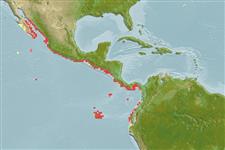Preferred temperature (Fonte Biblio.
123201): 19.2 - 23.1, mean 22.3 °C (based on 8 cells).
Phylogenetic diversity index (Fonte Biblio.
82804): PD
50 = 0.5312 [Uniqueness, from 0.5 = low to 2.0 = high].
Bayesian length-weight: a=0.02692 (0.01267 - 0.05719), b=2.92 (2.74 - 3.10), in cm total length, based on LWR estimates for this (Sub)family-body shape (Ref.
93245).
Trophic level (Fonte Biblio.
69278): 3.3 ±0.35 se; based on food items.
Resilienza (Fonte Biblio.
120179): Medio, tempo minimo di raddoppiamento della popolazione 1.4 - 4.4 anni (Preliminary K or Fecundity.).
Fishing Vulnerability (Ref.
59153): Low to moderate vulnerability (30 of 100).
🛈
Nutrients (Ref.
124155): Calcium = 38.8 [16.1, 92.6] mg/100g; Iron = 0.572 [0.297, 1.272] mg/100g; Protein = 18.4 [16.3, 20.6] %; Omega3 = 0.107 [0.054, 0.207] g/100g; Selenium = 34.1 [18.1, 70.8] μg/100g; VitaminA = 50 [14, 174] μg/100g; Zinc = 1.02 [0.70, 1.52] mg/100g (wet weight);
